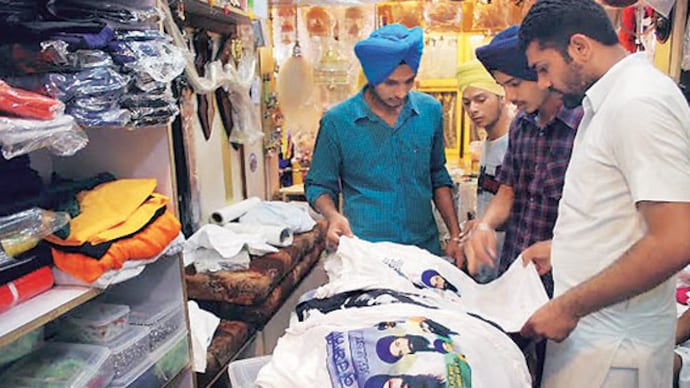Days of terror: Punjab back in 1980s, writes Manjeet Sehgal
Today in Punjab, the cult behind Bhindranwale has not vanished but grown - with many of his followers regarding him a saint and proudly sporting accessories and clothes bearing his photo.


Jarnail Singh Bhindranwale may have died 30 years ago but some Sikhs still remember him with reverence.
In fact in today's Punjab, Bhindranwale's cult has not vanished but grown - with many of his followers regarding him as 'Sant Ji' (a saint) and proudly sporting accessories and clothes bearing his photo. The craze for Bhindranwale can be gauged both from sales of his biography, and from songs, films, posters and other merchandise bearing his name. This craze is not just limited to Sikhs but extends to non-Sikhs as well.
Why do Punjabis find Bhindranwale relevant today?
The answer perhaps lies in the roots of the circumstances that transformed a simple village boy into a dedicated preacher and then a separatist leader. Punjab, during the early eighties, was passing through a phase of change. The lure to migrate to Western countries had compelled people to adopt all methods of 'Kabutarbazi', leading them to fall prey to greedy travel agents. Unemployment and crop failure were pushing the society towards a state of despair. THIS was the time Jarnail Singh Bhindranwale appeared on the horizon. Born on February 12, 1947, at the village of Rode in Faridkot, to Joginder Singh and Nihal Kaur, Jarnail Singh had little formal education but soon became a religious scholar. He remained in his village till the age of 11. He married Pritam Kaur in 1966 and fathered two sons named Ishar Singh and Inderjeet Singh, born in 1971 and 1975, respectively. On August 25, 1977, Bhindranwale was made the 14th head of Damdami Taksal, the 300-yearold Sikh educational organisation located in Chowk Mehta, 25 km from Amritsar. He headed this organisation till he was killed on June 6, 1984. Jarnail Singh followed the footsteps of previous heads and toured to distant places to promote Sikhism. His Amrit Prachar was a resounding success as he asked people to give up liquor, tobacco and drugs.
To rein in the rampant pornography, Bhindranwale's followers stormed cinema-houses and rural video parlours and seized obscene films. The result: thousands of Sikhs were reinitiated into their faith, and people returned to gurdwaras in large numbers. People also started spending more time in their fields. As a result, Jarnail Singh came to be revered by his followers as Baba Sant Jarnail Singh Khalsa Bhindranwale. However, even in those early days, Bhindranwale had a penchant for violence. On April 13, 1978, he organised a protest to stop the assembly of Nirankari Mission in Amritsar. Unfortunately the peaceful protest turned out to be a violent one when Nirankari gunmen allegedly killed 13 unarmed Sikh protesters and left 78 injured. Bhindranwale was made a prime suspect in the assassination of the Nirankari mission head Gurbachan Singh's which took place on April 24, 1980.
He was also accused of the murder of Lala Jagat Narain, killed on September 9, 1981. Jarnail Singh was arrested on September 20, 1981 but released after 25 days. These incidents had wider repercussions as they created a rift between Hindus and Sikhs. While Sikhs were dubbed as 'anti-national' and 'anti-Hindu' Jarnail Singh stated the government was discriminating against Sikhs who, according to him, were still being treated as 'slaves.' The result was the demand for a separate Sikh nation - Khalistan.
Khalistani terrorists started killing Hindus and the exodus of Hindus from Punjab began as the cracks widened between the two communities. Interestingly, while many believe Bhindranwale was behind the demand Khalistan, in truth is that he neither supported nor rejected this demand. Suffice to say the law and order situation in Punjab deteriorated and Jarnail Singh and his entourage moved to the Golden Temple complex (Akal Takht). He allegedly fortified the temple with heavy machineguns.
The Sikh clergy objected but Jarnail Singh got political patronage from Gurcharan Singh Tohra, the then President of the SGPC.
The rest is history.
What does Bhindranwale and the scenario of the 1980s have to do with today's Punjab?
Quite a lot.
Firstly, Bhindranwale is very much alive in the minds of some Sikhs. Radical Sikh singers like K.S. Makhan have sung songs in his praise and his popularity as a reformer and warrior is not going to go away easily. Secondly, the Punjab of today is facing many of the problems that gripped the state in the 1980s. Failed crops, poor revenue generation and faulty fiscal planning has derailed the state's economy, with unemployment at an all time high. Vices like drugs and alcoholism are coming back to haunt the state. Some here hold the belief today's scenario calls for another Bhindranwale.